Amenorrhea

Amenorrhea
Amenorrhea: Unraveling Symptoms, Causes, and Types
Amenorrhea refers to the absence of menstrual periods in women of reproductive age. It can be a temporary or persistent condition, and understanding its symptoms, causes, and types is crucial for accurate diagnosis and appropriate management.
Symptoms:
- Absence of Menstrual Periods:
– The primary symptom of amenorrhea is the absence of menstrual periods. It is defined as the lack of menstruation for at least three consecutive menstrual cycles.
- Pelvic Pain or Headaches:
– Some women with amenorrhea may experience pelvic pain or headaches, although these symptoms can vary widely among individuals.
- Changes in Breast Tenderness:
– Changes in breast tenderness or size may be observed, and these can be associated with hormonal imbalances contributing to amenorrhea.
- Hot Flashes or Night Sweats:
– In some cases, women may experience symptoms typically associated with menopause, such as hot flashes or night sweats.
- Vaginal Dryness:
– Vaginal dryness can occur, often related to hormonal imbalances affecting reproductive tissues.
- Changes in Libido:
– Fluctuations in hormonal levels can influence libido, potentially leading to changes in sexual desire.
Causes:
- Pregnancy:
– Pregnancy is a common cause of amenorrhea. Women who are pregnant do not typically menstruate.
- Hormonal Imbalances:
– Imbalances in hormones, including disruptions in the hypothalamus-pituitary-ovarian axis, can lead to amenorrhea. Conditions such as polycystic ovary syndrome (PCOS) or thyroid disorders can contribute.
- Stress and Emotional Factors:
– High levels of stress or emotional factors can impact the hormonal regulation of the menstrual cycle, leading to temporary amenorrhea.
- Excessive Exercise:
– Intense physical activity, especially in athletes, can lead to amenorrhea. This is often referred to as exercise-induced amenorrhea.
- Low Body Weight or Eating Disorders:
– Low body weight or extreme dieting, as seen in eating disorders like anorexia nervosa, can disrupt hormonal balance and cause amenorrhea.
- Chronic Illness:
– Chronic illnesses, such as diabetes or autoimmune disorders, can affect hormonal regulation and contribute to amenorrhea.
- Polycystic Ovary Syndrome (PCOS):
– PCOS is a common hormonal disorder in women of reproductive age, characterized by irregular periods, ovarian cysts, and elevated androgen levels. It is a leading cause of amenorrhea.
- Premature Ovarian Failure:
– Premature ovarian failure occurs when the ovaries stop functioning before the age of 40. It can lead to amenorrhea and infertility.
- Structural Abnormalities:
– Structural abnormalities in the reproductive organs, such as congenital anomalies or scarring due to surgeries, can contribute to amenorrhea.
- Medications:
– Certain medications, such as certain contraceptives or antipsychotics, can affect menstrual cycles and lead to amenorrhea.
Types:
- Primary Amenorrhea:
– Primary amenorrhea refers to the absence of menstrual periods in a woman who has not experienced her first period (menarche) by the age of 16. This may be due to factors such as genetic abnormalities, hormonal imbalances, or anatomical issues.
- Secondary Amenorrhea:
– Secondary amenorrhea occurs when a woman who previously had regular menstrual cycles experiences the absence of periods for three or more consecutive cycles. It is often associated with factors like pregnancy, hormonal imbalances, stress, or medical conditions.
- Physiological Amenorrhea:
– Physiological amenorrhea refers to the natural absence of menstrual periods during specific life stages, such as pregnancy, lactation, or menopause.
- Hypothalamic Amenorrhea:
– Hypothalamic amenorrhea is characterized by disruptions in the hypothalamus, leading to hormonal imbalances and the absence of menstrual periods. It can be triggered by factors like excessive exercise, low body weight, or emotional stress.
- Premature Ovarian Failure (Premature Menopause):
– Premature ovarian failure involves the cessation of ovarian function before the age of 40. It leads to hormonal imbalances, including low estrogen levels, and results in amenorrhea.
- Polycystic Ovary Syndrome (PCOS):
– PCOS is a common cause of amenorrhea, characterized by irregular periods, ovarian cysts, and hormonal imbalances.
- Functional Hypothalamic Amenorrhea:
– Functional hypothalamic amenorrhea results from disruptions in the hypothalamus due to factors such as excessive exercise, low body weight, or emotional stress.
Dysmenorrhea (Painful menses)
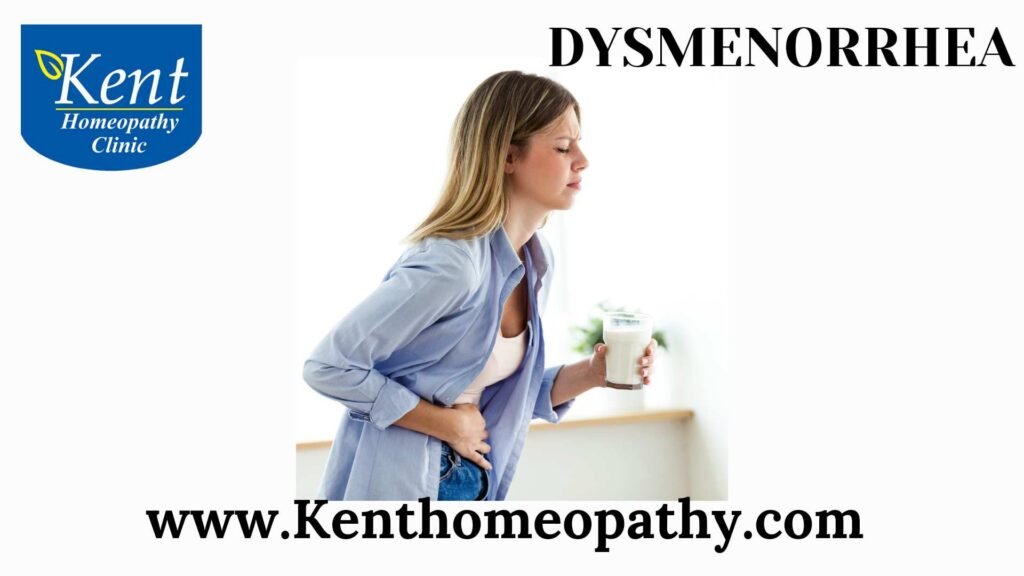
Dysmenorrhea (Painful menses)
Dysmenorrhea refers to the medical term for painful menstruation, commonly known as menstrual cramps. It is a common condition that affects many menstruating individuals and can vary in intensity from mild to severe. Dysmenorrhea is classified into two main types: primary dysmenorrhea and secondary dysmenorrhea.
Symptoms:
- Menstrual Cramps: The hallmark symptom is pelvic pain or cramping that usually begins a day or two before menstruation and may last for several days.
- Lower Abdominal Pain: The pain is typically felt in the lower abdomen but can radiate to the lower back and thighs.
- Nausea and Vomiting: Some individuals may experience nausea or vomiting during severe cramping episodes.
- Headaches: Headaches or dizziness can accompany menstrual cramps in some cases.
- Fatigue: The pain and discomfort associated with dysmenorrhea can lead to fatigue and a general feeling of unwellness.
Causes:
- Primary Dysmenorrhea: This type is not associated with any other medical condition and is considered a normal part of the menstrual cycle. It is believed to be caused by the release of prostaglandins, hormone-like substances that cause the uterus to contract.
- Secondary Dysmenorrhea: This type is related to an underlying reproductive health issue. Causes may include:
– Endometriosis: The presence of endometrial tissue outside the uterus.
– Fibroids: Noncancerous growths in the uterus.
– Pelvic Inflammatory Disease (PID): Infection of the reproductive organs.
– Adenomyosis: The presence of endometrial tissue within the muscular walls of the uterus.
Types:
- Primary Dysmenorrhea: Occurs in the absence of any other reproductive health issues. It usually begins 1-2 days before menstruation and lasts 2-4 days.
- Secondary Dysmenorrhea: Results from an underlying reproductive health condition. The timing and duration of pain may vary, and it is often associated with other symptoms related to the underlying condition.
It’s essential for individuals experiencing severe or debilitating menstrual cramps to consult a healthcare professional for an accurate diagnosis and appropriate management. Secondary dysmenorrhea, in particular, requires investigation into the underlying cause to ensure effective treatment and address any potential reproductive health issues.
Endometriosis
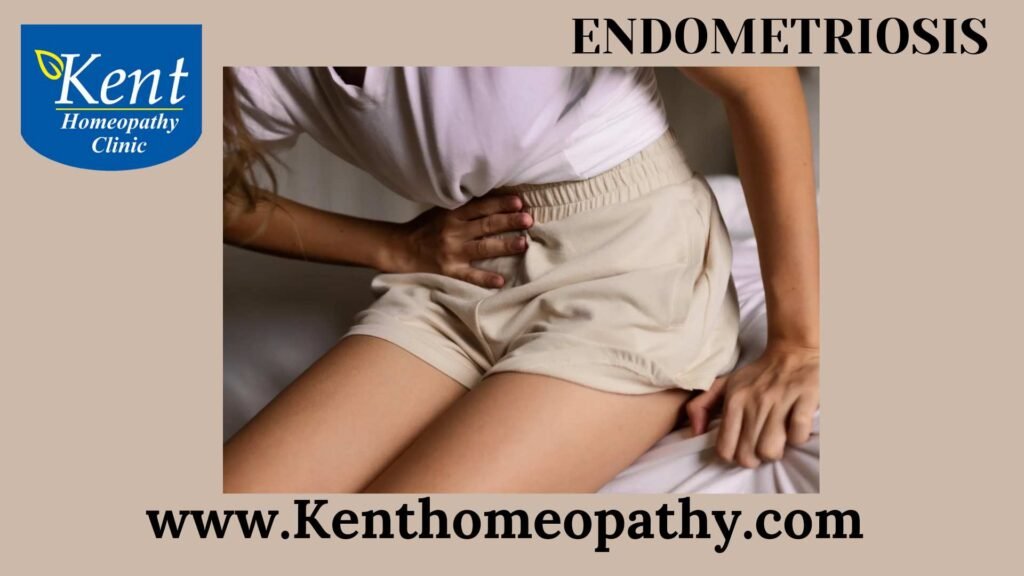
Endometriosis
Endometriosis is a chronic medical condition where tissue similar to the lining of the uterus, called endometrium, grows outside the uterus. This tissue responds to hormonal changes during the menstrual cycle, leading to inflammation, pain, and the formation of scar tissue. Endometriosis can affect various organs in the pelvic cavity and is a common cause of chronic pelvic pain in women.
Symptoms:
- Pelvic Pain: The most common symptom is pelvic pain that can range from mild to severe. The pain often increases during menstruation.
- Painful Menstrual Periods: Women with endometriosis often experience more intense menstrual cramps than usual.
- Painful Intercourse: Pain during or after sexual intercourse, known as dyspareunia, can be a symptom of endometriosis.
- Abnormal Menstrual Bleeding: This may include heavy periods, irregular bleeding, or bleeding between periods.
- Gastrointestinal Symptoms: Endometriosis can cause bowel-related symptoms such as bloating, diarrhea, constipation, or pain during bowel movements.
- Infertility: In some cases, endometriosis can contribute to fertility issues.
Causes: The exact cause of endometriosis is not fully understood, but several theories exist:
- Retrograde Menstruation: This theory suggests that menstrual blood containing endometrial cells flows backward into the pelvic cavity instead of out of the body, leading to the implantation of these cells on pelvic organs.
- Immune System Dysfunction: Some researchers propose that a compromised immune system may allow the survival and growth of endometrial cells outside the uterus.
- Genetic Predisposition: There is evidence that genetic factors may contribute to an increased susceptibility to endometriosis.
- Surgical Scarring: Previous surgeries, such as cesarean sections or hysterectomies, may contribute to the development of endometriosis.
Types:
- Superficial Peritoneal Endometriosis: Involves the growth of endometrial tissue on the peritoneum, the thin membrane lining the abdominal cavity.
- Ovarian Endometriomas (Chocolate Cysts): Cysts filled with old, dark blood develop on the ovaries.
- Deep Infiltrating Endometriosis (DIE): The most severe form, DIE involves the invasion of endometrial tissue into deeper layers of pelvic organs such as the bowel or bladder.
- Adenomyosis: While technically a separate condition, adenomyosis shares similarities with endometriosis. It involves the invasion of endometrial tissue into the muscular wall of the uterus.
Endometriosis is a chronic condition that requires comprehensive management, often involving a multidisciplinary approach with gynecologists, pain specialists, and fertility experts. Early diagnosis and tailored treatment plans can help improve quality of life for individuals living with endometriosis.
Fibroadenoma (Breast tumour)

Fibroadenoma (Breast tumour)
Fibroadenoma is a common benign (non-cancerous) breast tumor that primarily affects women. These tumors are composed of both glandular and connective tissue and typically present as well-defined, smooth, and rubbery lumps in the breast. While fibroadenomas are generally harmless, they can cause discomfort or anxiety and may be surgically removed in some cases.
Symptoms:
- Breast Lump: The most common symptom of fibroadenoma is the presence of a painless, easily movable lump in the breast. These lumps are usually round or oval-shaped.
- Change in Size: Fibroadenomas may change in size over time, often becoming more noticeable during the menstrual cycle when hormonal changes occur.
- Breast Pain or Tenderness: Some individuals may experience tenderness or discomfort in the breast, especially if the fibroadenoma is large.
Causes:
- Hormonal Influence: Hormonal changes, particularly those associated with the menstrual cycle, may contribute to the development and growth of fibroadenomas. They are more common in women of reproductive age.
- Estrogen Sensitivity: Fibroadenomas often contain estrogen receptors, suggesting a sensitivity to estrogen levels in the body.
- Genetic Factors: There may be a genetic predisposition to developing fibroadenomas, as they can run in families.
Types:
- Simple Fibroadenoma: This is the most common type and is characterized by a well-defined lump without complex features. It is usually not associated with an increased risk of breast cancer.
- Complex Fibroadenoma: This type may have features that raise concerns, such as increased cellularity or the presence of cysts. While still benign, complex fibroadenomas may be monitored more closely.
- Giant Fibroadenoma: These are larger fibroadenomas that can grow to a size greater than 5 centimeters. While benign, they may be surgically removed if they cause discomfort or distort the breast shape.
It’s important for individuals to seek medical evaluation if they notice any changes in their breast tissue. While fibroadenomas are typically benign, a healthcare provider can perform the necessary examinations and tests to determine the nature of the breast lump and recommend appropriate management. Regular breast self-exams and mammograms are also essential for overall breast health.
Hot Flushes

Hot Flushes
Hot Flashes (Hot Flushes): Understanding Symptoms, Causes, and Types
Hot flashes, also known as hot flushes, are a common phenomenon experienced by many individuals, particularly women, during various life stages. These sudden and intense sensations of heat, often accompanied by sweating and a reddening of the skin, can be disruptive and are frequently associated with hormonal changes. Understanding the symptoms, causes, and types of hot flashes is crucial for those experiencing them and for effective management.
Symptoms:
- Sudden Heat Sensation: The hallmark symptom of hot flashes is a sudden feeling of intense heat, usually beginning in the upper body and spreading to the face and neck.
- Redness and Flushing: The skin may become noticeably red or flushed during a hot flash episode.
- Sweating: Profuse sweating often accompanies a hot flash, contributing to a feeling of being overheated.
- Rapid Heartbeat: An increased heart rate or palpitations may occur during or after a hot flash.
- Chills: Following a hot flash, some individuals may experience a sensation of chills or shivering.
Causes:
Hot flashes are primarily associated with hormonal changes, particularly fluctuations in estrogen levels. They can occur for various reasons:
- Menopause: The most common cause of hot flashes is menopause. During menopause, a woman’s ovaries gradually produce less estrogen and progesterone, leading to hormonal imbalances that trigger hot flashes.
- Perimenopause: The transitional period leading up to menopause, known as perimenopause, can also cause hormonal fluctuations and result in hot flashes.
- Surgical Menopause: Women who undergo surgical removal of the ovaries (oophorectomy) may experience abrupt hormonal changes, leading to hot flashes.
- Hormonal Treatments: Some cancer treatments, particularly hormonal therapies for breast or prostate cancer, can induce hot flashes as a side effect.
- Medications: Certain medications, such as certain antidepressants, can cause hot flashes as a side effect.
- Medical Conditions: Certain medical conditions, including hyperthyroidism and certain neurological disorders, can contribute to the occurrence of hot flashes.
Types:
- Menopausal Hot Flashes: The most common type, occurring during the menopausal transition and beyond as a result of hormonal changes.
- Postmenopausal Hot Flashes: Hot flashes that persist after menopause.
- Perimenopausal Hot Flashes: Hot flashes that occur during the transitional phase leading up to menopause.
- Surgical Menopausal Hot Flashes: Resulting from surgical removal of the ovaries, leading to abrupt hormonal changes.
- Secondary to Cancer Treatments: Hot flashes induced by hormonal therapies used in the treatment of certain cancers.
Conclusion:
Hot flashes, while a common and often temporary phenomenon, can significantly impact an individual’s quality of life. Understanding the underlying causes, types, and effective management strategies is essential for those experiencing hot flashes to navigate this natural yet challenging aspect of life transitions, particularly menopause. Seeking medical advice for a personalized approach ensures that individuals receive the most suitable interventions based on their unique circumstances.
Infertility

Infertility
Infertility: Unraveling Symptoms, Causes, and Types
Infertility is a medical condition characterized by the inability to conceive after a year of regular, unprotected intercourse. Both men and women can experience fertility issues, and it can be a challenging and emotionally taxing journey for individuals or couples trying to build a family. Understanding the symptoms, causes, and types of infertility is essential for seeking appropriate medical guidance and treatment.
Symptoms:
- Failure to Conceive: The primary symptom of infertility is the inability to achieve pregnancy after a year of regular, unprotected sex. However, if a woman is over 35 years old, it is advisable to seek medical advice after six months of unsuccessful attempts due to the potential decline in fertility with age.
- Irregular Menstrual Cycles: Irregular or absent menstrual cycles can be indicative of ovulatory disorders in women, affecting their ability to conceive.
- Painful Menstruation or Intercourse: Conditions such as endometriosis, pelvic inflammatory disease (PID), or fibroids may cause pain during menstruation or sexual intercourse, potentially impacting fertility.
- Changes in Libido: Sexual dysfunction or changes in libido may be associated with fertility issues, particularly if it interferes with regular attempts at conception.
- Male Factor Symptoms: In men, symptoms may include changes in sexual function, pain or swelling in the testicles, or hormonal imbalances affecting sperm production.
Causes:
- Ovulatory Disorders: Irregular ovulation or failure to ovulate is a common cause of female infertility. Conditions such as polycystic ovary syndrome (PCOS) can disrupt the regular release of eggs.
- Endometriosis: Endometriosis occurs when tissue similar to the lining of the uterus grows outside the uterus, affecting the function of the reproductive organs and potentially causing infertility.
- Fallopian Tube Blockage: Blocked or damaged fallopian tubes can prevent the egg from reaching the uterus or hinder sperm from reaching the egg.
- Uterine Issues: Abnormalities in the structure of the uterus, such as fibroids or polyps, can interfere with implantation or hinder the development of a fertilized egg.
- Male Factor Infertility: Male infertility can result from issues such as low sperm count, poor sperm motility, or abnormalities in sperm morphology.
- Age-Related Decline: Female fertility declines with age, particularly after the age of 35, due to a decrease in the quantity and quality of eggs.
- Pelvic Inflammatory Disease (PID): Infections affecting the reproductive organs, like PID, can cause scarring and damage to the fallopian tubes, leading to infertility.
- Unexplained Infertility: In some cases, despite thorough testing, the cause of infertility remains unexplained, making treatment more challenging.
Types:
- Primary Infertility: Couples experiencing primary infertility have never conceived, despite regular attempts over an extended period.
- Secondary Infertility: Secondary infertility occurs when a couple has conceived at least once previously but struggles to conceive again.
- Female Infertility: Factors such as ovulatory disorders, endometriosis, or issues with the uterus contribute to female infertility.
- Male Infertility: Male infertility is attributed to problems with sperm production, motility, or morphology. Conditions like varicocele, hormonal imbalances, or genetic factors can contribute.
- Combined Infertility: In some cases, both partners may have contributing factors, leading to combined or dual infertility.
- Age-Related Infertility: Advanced maternal age significantly impacts female fertility. It is often associated with a decline in the quantity and quality of eggs.
- Structural Infertility: Issues with the structure of reproductive organs, such as blocked fallopian tubes or abnormalities in the uterus, fall under this category.
- Functional Infertility: Conditions affecting the normal functioning of reproductive organs, like ovulatory disorders or hormonal imbalances, contribute to functional infertility.
Menstrual Problems

Menstrual Problems
Menstrual Problems: Unraveling Symptoms, Causes, and Types
Menstrual problems encompass a range of conditions affecting the menstrual cycle, which is a natural and essential part of a woman’s reproductive health. These problems can manifest as irregular periods, painful menstruation, heavy bleeding, or the absence of menstruation altogether. Understanding the symptoms, causes, and types of menstrual problems is crucial for proper diagnosis and management.
Symptoms:
- Irregular Menstrual Cycles: Irregular periods involve variations in the length of the menstrual cycle or unpredictable timing between periods. This may include periods occurring too frequently or too infrequently.
- Amenorrhea: Amenorrhea is the absence of menstruation. Primary amenorrhea refers to the absence of a first menstrual period by the age of 16, while secondary amenorrhea is the cessation of menstruation for three or more consecutive cycles in a woman who previously had regular periods.
- Dysmenorrhea: Dysmenorrhea refers to painful menstruation. Primary dysmenorrhea is common menstrual cramping without an underlying medical condition, while secondary dysmenorrhea is associated with pelvic abnormalities or conditions such as endometriosis.
- Menorrhagia: Menorrhagia involves heavy menstrual bleeding that lasts longer than seven days or requires frequent changing of tampons or pads.
- Metrorrhagia: Metrorrhagia is irregular, non-menstrual bleeding between periods. It may present as spotting or more significant bleeding.
- Oligomenorrhea: Oligomenorrhea refers to infrequent menstruation, with cycles longer than 35 days.
- Premenstrual Syndrome (PMS): PMS involves a combination of physical and emotional symptoms that occur in the days or weeks leading up to menstruation. Symptoms may include mood swings, bloating, breast tenderness, and fatigue.
Causes:
- Hormonal Imbalances: Hormonal fluctuations play a central role in menstrual regularity. Conditions such as polycystic ovary syndrome (PCOS), thyroid disorders, and hormonal imbalances can disrupt the normal menstrual cycle.
- Stress: Physical or emotional stress can impact the hypothalamus-pituitary-ovary axis, leading to menstrual irregularities. High levels of stress can affect hormone production and menstrual regularity.
- Underlying Health Conditions: Certain health conditions, such as diabetes, obesity, and inflammatory diseases, can influence the menstrual cycle.
- Structural Abnormalities: Structural issues within the reproductive organs, such as uterine fibroids, polyps, or abnormalities of the uterus or cervix, may contribute to menstrual problems.
- Blood Clotting Disorders: Conditions affecting blood clotting, such as von Willebrand disease or other bleeding disorders, can lead to heavy menstrual bleeding.
- Endometriosis: Endometriosis is a condition where tissue similar to the lining of the uterus grows outside the uterus. It can cause pain, irregular bleeding, and fertility issues.
- Pelvic Inflammatory Disease (PID): PID is an infection of the female reproductive organs, often caused by sexually transmitted infections. It can lead to inflammation and scarring, impacting menstrual regularity.
- Premature Ovarian Insufficiency (POI): POI occurs when the ovaries stop functioning before the age of 40, leading to irregular or absent menstrual periods.
- Certain Medications: Some medications, such as certain types of contraceptives, anticoagulants, or chemotherapy drugs, can influence menstrual patterns.
- Extreme Weight Changes: Rapid weight loss or gain, as well as eating disorders, can disrupt hormonal balance and affect menstrual cycles.
Types:
- Primary Dysmenorrhea: Common menstrual cramping without an underlying medical condition. It typically starts one to two days before menstruation and may last two to four days.
- Secondary Dysmenorrhea: Painful menstruation associated with an underlying reproductive health issue, such as endometriosis, fibroids, or pelvic inflammatory disease.
- Polymenorrhea: Menstrual cycles that occur more frequently than every 21 days. This may result from hormonal imbalances.
- Oligomenorrhea: Infrequent menstruation with cycles longer than 35 days. Hormonal imbalances, PCOS, or ovarian insufficiency can contribute to oligomenorrhea.
- Amenorrhea: Absence of menstruation. Primary amenorrhea is the absence of a first menstrual period, and secondary amenorrhea is the cessation of menstruation in a woman who previously had regular periods.
- Menorrhagia: Heavy menstrual bleeding lasting more than seven days or requiring frequent changing of tampons or pads. Causes include hormonal imbalances, uterine fibroids, or bleeding disorders.
- Metrorrhagia: Irregular, non-menstrual bleeding between periods. It may indicate hormonal issues, uterine abnormalities, or conditions like endometriosis.
- Dysfunctional Uterine Bleeding (DUB): Abnormal uterine bleeding not associated with structural abnormalities. It is often linked to hormonal imbalances.
- Premenstrual Syndrome (PMS): A combination of physical and emotional symptoms occurring before menstruation. It may include mood swings, bloating, breast tenderness, and fatigue.
- Premenstrual Dysphoric Disorder (PMDD): A severe form of PMS characterized by significant mood disturbances and emotional symptoms.
Ovarian Cysts
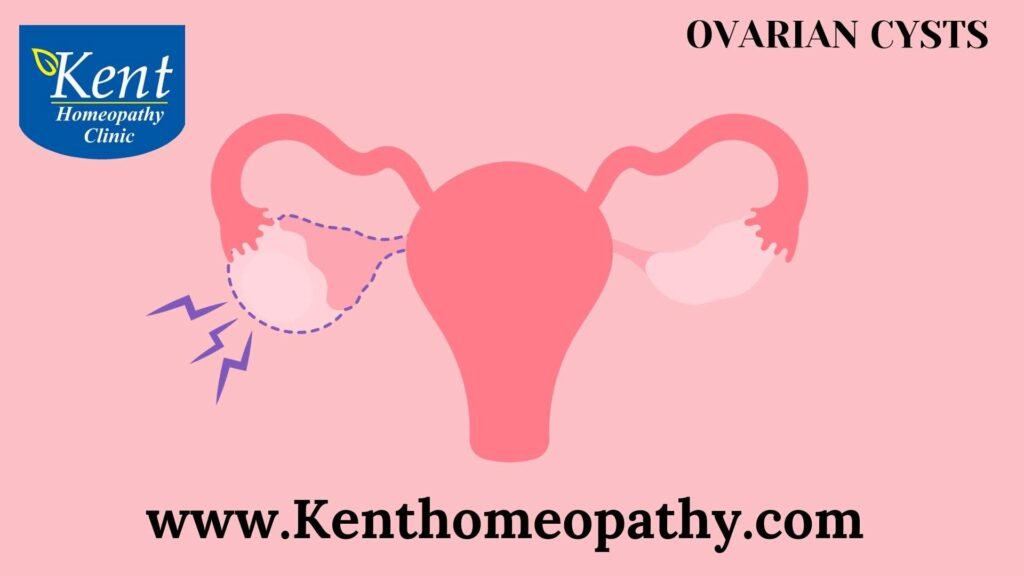
Ovarian Cysts
Ovarian Cysts: Understanding Symptoms, Causes, and Types
Ovarian cysts are fluid-filled sacs that develop within or on the surface of the ovaries. While many cysts are harmless and resolve on their own, others may cause symptoms or complications. Exploring the symptoms, causes, and types of ovarian cysts is crucial for accurate diagnosis and appropriate management.
Symptoms:
- Pelvic Pain:
– Pelvic pain, ranging from a dull ache to sharp discomfort, is a common symptom of ovarian cysts. The pain may be felt on one side of the pelvis, depending on the location of the cyst.
- Bloating or Fullness:
– Ovarian cysts can cause a feeling of bloating or fullness in the abdomen. This sensation may be accompanied by a distended or swollen appearance.
- Painful Intercourse:
– Some women with ovarian cysts may experience pain during sexual intercourse, especially if the cyst puts pressure on surrounding tissues.
- Changes in Menstrual Patterns:
– Ovarian cysts can affect menstrual cycles, leading to irregular periods, heavy bleeding, or changes in the length of the menstrual cycle.
- Painful Bowel Movements:
– Large cysts may exert pressure on nearby structures, causing discomfort or pain during bowel movements.
- Frequent Urination:
– Cysts that put pressure on the bladder can result in an increased urge to urinate or a feeling of incomplete emptying.
- Nausea or Vomiting:
– Severe pain or complications from ovarian cysts may cause nausea or vomiting.
- Breast Tenderness:
– Changes in hormonal levels associated with ovarian cysts can contribute to breast tenderness.
Causes:
- Functional Ovarian Cysts:
– The most common type, functional ovarian cysts, develop as a result of the normal menstrual cycle. These cysts include follicular cysts (develop during ovulation) and corpus luteum cysts (form after the egg is released).
- Endometriomas:
– Endometriomas result from endometriosis, a condition where tissue similar to the lining of the uterus grows outside the uterus. This tissue can form cysts on the ovaries.
- Cystadenomas:
– Cystadenomas are growths that develop on the surface of the ovaries and are filled with a watery or mucous-like substance.
- Dermoid Cysts:
– Dermoid cysts are ovarian growths that can contain various types of tissues, including hair, skin, teeth, and other tissues.
- Polycystic Ovary Syndrome (PCOS):
– PCOS is a hormonal disorder that can lead to the formation of multiple small cysts on the ovaries. These cysts are often associated with irregular menstrual cycles and hormonal imbalances.
- Ovarian Tumors:
– Non-functional ovarian tumors, both benign and malignant, can present as cystic masses on the ovaries.
- Pregnancy:
– During early pregnancy, a cyst known as a corpus luteum cyst forms on the ovary. While this is a normal part of pregnancy, it can occasionally cause discomfort.
- Pelvic Infections:
– Infections affecting the pelvic region can lead to the development of cysts.
Types:
- Functional Ovarian Cysts:
– Follicular Cysts: Develop when a follicle doesn’t release an egg during the menstrual cycle.
– Corpus Luteum Cysts: Form after the release of an egg when the empty follicle doesn’t shrink as it should.
- Endometriomas:
– Endometriomas are cysts that result from endometriosis, where tissue similar to the lining of the uterus grows outside the uterus, causing cysts on the ovaries.
- Cystadenomas:
– Cystadenomas are growths on the surface of the ovaries, typically filled with a watery or mucous-like substance. They can be benign or malignant.
- Dermoid Cysts:
– Dermoid cysts are ovarian growths containing various tissues, including hair, skin, teeth, and other tissues. They are often benign.
- Polycystic Ovary Syndrome (PCOS):
– PCOS is a hormonal disorder characterized by the presence of multiple small cysts on the ovaries. These cysts are associated with irregular menstrual cycles and hormonal imbalances.
PCOS/PCOD & women related disorders
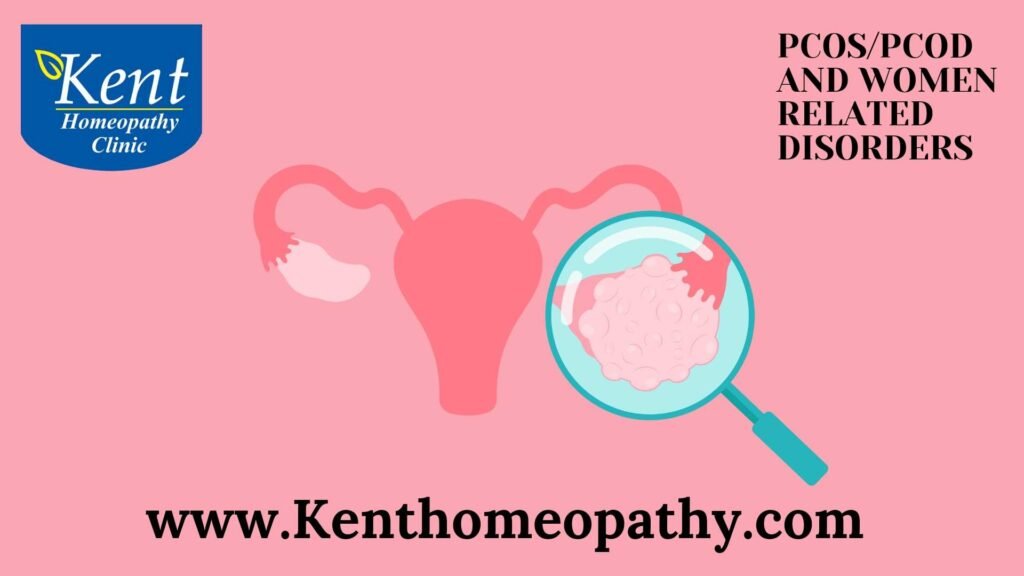
PCOS/PCOD & women related disorders
PCOS/PCOD and Related Women’s Disorders
Polycystic Ovary Syndrome (PCOS) and Polycystic Ovary Disorder (PCOD) are common hormonal conditions affecting women, typically during reproductive years. Both cause an imbalance in reproductive hormones, affecting ovarian function and leading to various symptoms.
Symptoms:
Common symptoms include irregular or absent periods, heavy menstrual bleeding, and difficulties with fertility. High androgen (male hormone) levels can lead to acne, excessive facial or body hair, and hair thinning or male-pattern baldness. Many women with PCOS/PCOD experience weight gain, dark patches of skin, skin tags, and even anxiety or depression due to hormonal fluctuations.
Causes:
The precise cause of PCOS/PCOD remains unclear, but genetics and lifestyle are influential. Insulin resistance—when the body doesn’t use insulin effectively—is common in these conditions, leading to higher blood sugar and potentially increased androgen production by the ovaries, which worsens symptoms. Chronic inflammation is also thought to contribute, as it may increase androgen levels and interfere with hormone regulation.
Types:
PCOS and PCOD can be classified into four main types:
1. Insulin-resistant PCOS – Associated with high insulin levels and is the most prevalent form.
2. Post-pill PCOS – Symptoms appear or worsen after stopping hormonal birth control.
3. Inflammatory PCOS – Driven by chronic inflammation, linked to stress and lifestyle factors.
4. Adrenal PCOS – Caused by excess stress hormones rather than ovarian dysfunction, leading to increased androgens from adrenal glands.
Conclusion:
Management of PCOS and PCOD involves lifestyle adjustments like a nutritious diet, regular exercise, and stress reduction. Addressing insulin resistance and inflammation is crucial, and treatment plans may include medications to manage symptoms. Early intervention is important to mitigate long-term health risks and improve quality of life.
Pelvic Inflammatory disease

Pelvic Inflammatory disease
Pelvic Inflammatory Disease (PID): Unveiling Symptoms, Causes, and Types
Pelvic Inflammatory Disease (PID) is an infection of a woman’s reproductive organs, often caused by sexually transmitted infections (STIs). PID can have serious consequences if left untreated, affecting fertility and increasing the risk of ectopic pregnancies. Understanding the symptoms, causes, and types of PID is crucial for early diagnosis and effective management.
Symptoms of Pelvic Inflammatory Disease:
- Pelvic Pain:
– Persistent and often severe pain in the lower abdomen is a common symptom of PID. The pain may be dull, crampy, or sharp.
- Abnormal Vaginal Discharge:
– Unusual discharge that may have an unpleasant odor is another indicator. The discharge may be yellow or green and may be more noticeable after intercourse.
- Painful Urination:
– Discomfort or pain during urination may occur, resembling symptoms of a urinary tract infection (UTI).
- Irregular Menstrual Bleeding:
– PID can lead to changes in menstrual patterns, including heavier or more painful periods.
- Painful Intercourse:
– Pain or discomfort during sexual intercourse, known as dyspareunia, is a common symptom.
- Fever and Chills:
– Elevated body temperature, fever, and chills may accompany PID, indicating the presence of infection.
- Painful Ovulation:
– Some women with PID experience pain during ovulation, which occurs in the middle of the menstrual cycle.
- Fatigue:
– Generalized weakness or fatigue may be present, reflecting the body’s response to infection.
Causes of Pelvic Inflammatory Disease:
- Sexually Transmitted Infections (STIs):
– The primary cause of PID is the spread of bacteria from the vagina or cervix into the upper reproductive organs. Common culprits include Chlamydia and Gonorrhea.
- Bacterial Vaginosis:
– An overgrowth of harmful bacteria in the vagina can contribute to the development of PID.
- IUD Use:
– Women who use intrauterine devices (IUDs) for contraception may have a slightly increased risk of PID, particularly in the first few weeks after insertion.
- Postpartum or Post-Abortion Infections:
– Infections that occur after childbirth or abortion procedures can sometimes lead to PID.
- Douching:
– Regular douching may disrupt the balance of bacteria in the vagina, increasing the risk of infection.
- Cervical Procedures:
– Certain procedures involving the cervix, such as biopsies or the insertion of cervical devices, can introduce bacteria and lead to PID.
Types of Pelvic Inflammatory Disease:
- Acute PID:
– Acute PID refers to the initial and active phase of the infection. It often presents with severe symptoms, and prompt treatment is essential to prevent complications.
- Chronic PID:
– If PID is not adequately treated during the acute phase, it can become chronic. Chronic PID may involve persistent inflammation and damage to reproductive organs, leading to long-term complications such as infertility.
- Tubo-Ovarian Abscess:
– In severe cases, an abscess may form in the fallopian tubes or ovaries. This complication can result in more intense pain and may require drainage or surgical intervention.
- Fitz-Hugh-Curtis Syndrome:
– This rare complication of PID involves inflammation of the liver capsule, causing pain on the upper right side of the abdomen. It is more common in individuals with Chlamydia-related PID.
Polycystic ovarian disease
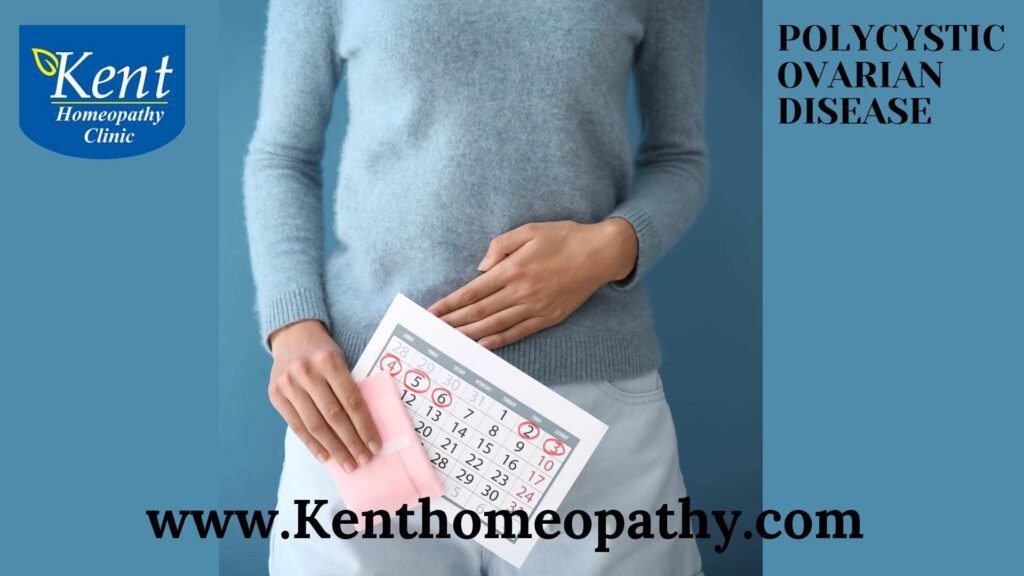
Polycystic ovarian disease
Polycystic Ovary Disorder (PCOD): A Concise Overview
Polycystic Ovary Disorder (PCOD), also known as Polycystic Ovary Syndrome (PCOS), is a common hormonal disorder affecting individuals with ovaries. It involves a range of symptoms and can impact reproductive and overall health. Here’s a brief overview of its symptoms, causes, and types.
Symptoms of PCOD:
- Menstrual Irregularities:
– PCOD often leads to irregular menstrual cycles. Women may experience infrequent periods, prolonged periods, or unpredictable bleeding.
- Ovulatory Dysfunction:
– Anovulation, the failure of ovaries to release eggs regularly, is a common feature of PCOD. This can contribute to fertility issues.
- Hyperandrogenism:
– Elevated levels of androgens, male hormones like testosterone, can lead to symptoms such as acne, excessive facial or body hair (hirsutism), and male-pattern baldness.
- Polycystic Ovaries:
– Ultrasound imaging may reveal the presence of multiple small cysts on the ovaries. However, not all individuals with PCOD will have polycystic ovaries.
- Insulin Resistance:
– PCOD is associated with insulin resistance, which can lead to elevated insulin levels. This may contribute to weight gain and difficulties in maintaining a healthy weight.
- Weight Gain:
– Many individuals with PCOD experience weight gain or find it challenging to manage their weight.
Causes of PCOD:
- Genetic Predisposition:
– There is a genetic component to PCOD, and individuals with a family history of the disorder may be at a higher risk.
- Insulin Resistance:
– Insulin resistance, where the body’s cells don’t respond effectively to insulin, is a key factor in PCOD. This leads to elevated insulin levels, contributing to hormonal imbalances.
- Hormonal Imbalances:
– Disruptions in the balance of hormones, including elevated levels of androgens and insulin, contribute to the symptoms of PCOD.
- Chronic Inflammation:
– Inflammation is thought to play a role in PCOD, impacting hormonal regulation and ovarian function.
Types of PCOD:
- Classic PCOD:
– Characterized by irregular periods, anovulation, hyperandrogenism, and polycystic ovaries on ultrasound, this is the most common type of PCOD.
- Non-Classic PCOD:
– Some individuals may exhibit a subset of symptoms without meeting all the criteria for a classic PCOD diagnosis. This non-classic presentation still involves hormonal imbalances and menstrual irregularities.
- Lean PCOD:
– While weight gain is a common symptom, some individuals with PCOD may have a lean or normal body weight. Lean PCOD is characterized by similar hormonal disruptions and ovarian abnormalities.
- Non-Hyperandrogenic PCOD:
– In this type, individuals may have irregular periods and polycystic ovaries without significant signs of hyperandrogenism. This form can still impact fertility and metabolic health.
Uterine fibroid

Uterine fibroid
Uterine Fibroids: Unraveling Symptoms, Causes, and Types
Uterine fibroids, also known as leiomyomas or myomas, are noncancerous growths of the uterus that often appear during childbearing years. These tumors can vary in size and location within the uterus, and while they are generally benign, they can cause a range of symptoms. Understanding the symptoms, causes, and types of uterine fibroids is crucial for proper diagnosis and management.
Symptoms:
- Menstrual Changes:
– Uterine fibroids can cause changes in menstrual patterns, including heavier or prolonged periods, irregular periods, and spotting between periods.
- Pelvic Pain and Pressure:
– Fibroids can lead to pelvic pain and a feeling of pressure in the lower abdomen. Large fibroids or those located near the surface of the uterus may cause noticeable swelling.
- Pelvic Pain During Intercourse:
– Fibroids can contribute to pain or discomfort during sexual intercourse, especially if the tumors are pressing on surrounding structures.
- Frequent Urination:
– Large fibroids that press against the bladder can cause increased frequency of urination. This symptom is more common when fibroids are located near the front of the uterus.
- Difficulty Emptying the Bladder:
– Fibroids pressing against the bladder may lead to difficulty emptying the bladder completely, resulting in a frequent need to urinate.
- Backache or Leg Pains:
– Fibroids can cause backache or leg pains, particularly if they exert pressure on nerves in the back or pelvis.
- Constipation or Difficulty with Bowel Movements:
– Fibroids pressing on the rectum can cause constipation or difficulty with bowel movements.
- Enlarged Abdomen:
– In some cases, the uterus may become enlarged, leading to an enlarged abdomen. This is more noticeable in larger fibroids or if multiple fibroids are present.
Causes:
- Genetic Factors:
– Genetic factors play a role in the development of uterine fibroids. Women with a family history of fibroids are more likely to develop them.
- Hormonal Factors:
– Estrogen and progesterone, hormones that regulate the menstrual cycle, appear to promote the growth of fibroids. Fibroids typically grow during reproductive years when hormone levels are higher.
- Pregnancy and Childbirth:
– Pregnancy-related hormonal changes and the growth of the uterus during pregnancy may contribute to the development of fibroids. However, fibroids often shrink after menopause when hormone levels decrease.
- Race and Ethnicity:
– Studies suggest that African American women are at a higher risk of developing fibroids compared to women of other racial and ethnic backgrounds.
- Age:
– Uterine fibroids are more common in women of reproductive age. They tend to shrink after menopause when estrogen and progesterone levels decline.
- Diet:
– Some studies suggest a link between diet, particularly a diet low in fruits and vegetables, and an increased risk of developing fibroids.
- Obesity:
– Women who are overweight or obese have an increased risk of developing fibroids. Obesity is associated with higher estrogen levels, which may contribute to fibroid growth.
Types:
- Intramural Fibroids:
– Intramural fibroids are the most common type and develop within the muscular wall of the uterus. They can cause enlargement of the uterus and contribute to menstrual changes, pelvic pain, and pressure.
- Subserosal Fibroids:
– Subserosal fibroids grow on the outer surface of the uterus and may create a bulge, leading to an enlarged abdomen. These fibroids can press on nearby organs, causing urinary or bowel symptoms.
- Submucosal Fibroids:
– Submucosal fibroids develop just beneath the lining of the uterine cavity. They can cause significant menstrual abnormalities, including heavy bleeding and irregular periods. Submucosal fibroids may also contribute to fertility issues.
- Pedunculated Fibroids:
– Pedunculated fibroids are attached to the uterus by a stalk or stem. They can be intramural, subserosal, or submucosal. Pedunculated fibroids may lead to pain or discomfort if the stalk undergoes torsion (twisting).
- Cervical Fibroids:
– Cervical fibroids develop in the cervix, the lower part of the uterus. They may cause pelvic pain and pressure and can affect bladder and bowel function.
Contact to know more
Contact
Timings
Monday to Saturday:
11:00 AM to 02:30 PM
06:30 PM to 09:00 PM
